2019 Most Common LEGO Parts
Most LEGO builders know that there are thousands of different LEGO parts in production, and some parts are a lot more common than others. Let’s find out which parts are the most common, which parts are available in the widest selection of colors, and which parts have become a lot more popular in the last few years!
January 16, 2020: While I haven’t had a chance to publish a revised article for 2020, I re-calculated the 600 most common LEGO parts. (The top 50 parts featured on this page did not change very much.)
Which LEGO parts are the most common?
This seems like it would be an easy question, but The LEGO Group is a privately held company that doesn’t share detailed information about which pieces they manufacture or how many copies of each set are sold. In order to answer this question, we need to work with the limitations of the data that we do have.
Thanks to websites like Brickset, BrickLink, and Rebrickable, we do have lists containing every known LEGO parts, every known LEGO set, and inventories containing a list of elements and quantities for each of those sets. We will use data imported from Rebrickable to estimate part production using inventories from sets released in recent years.
Why does it matter?
There are a couple reasons that I wanted to know which LEGO parts are most common. The first is pretty obvious—I wanted to make sure my collection of printable LEGO Brick Labels includes labels for all of the most common parts.
The second reason is that this information helps me offer better advice in the LEGO Storage Guide. As you move from a medium to large collection, you might want to sort the most common pieces by part instead of broad categories. Likewise, as your collection grows from a large to a very large collection, these are the first parts you might choose to sort by element (both part and color).
The third reason requires a little more explanation… Last year’s most visited article Hard-to-Find LEGO Colors (and what to do about it) analyzed which LEGO colors are “Common” because they are available in almost every part, “Uncommon” because they are available in many but not all parts, and “Rare” because they are available in so few parts that you can only use them sparingly. For that article, I created a list of basic bricks, plates, and tiles that I felt were necessary to build interesting models, and used that list of parts to assess how common each color is. For the upcoming 2019 update to that article, I wanted to use data (instead of my instincts) to select the most common parts, and use those parts to judge how common each color is.
Beyond these practical reasons, I found the list of the most common parts really interesting, and I thought my readers would find it interesting too. In this article, we’ll take extra step and analyze the data to learn more about the building blocks of our hobby.
Most Common LEGO Parts

The top 12 parts account for nearly 25% of all pieces manufactured. (Each part shown in it’s most common color.)
Even after trying to exclude printed parts, Minifigure parts, and Duplo pieces, you would have around 675,000 pieces if you purchased one of every set released from 2015-2019. That’s a respectable LEGO collection!
After adding up how many of each part you would get from each set, you end up with a long list of parts… I’ve included a list showing the Top 50 parts below. (The complete list of the Top 500 parts is on a different page to keep the page from loading too slowly.)
In addition to columns describing each part, you will find the number of pieces you would get if you bought one of every set, and the number of colors each part comes in. (Rows containing parts which come in 5 or fewer colors shown with light gray background.) You will also find the current rank, and the year-over-year change for that part (with +/- indicating increased/decreased popularity.)
Top 50 Parts by Number of Pieces
| Rank | Image | Part ID | Part Name | # Colors | # Pieces |
|---|---|---|---|---|---|
| 1 — |  |
3023 | 1×2 Plate | 49 | 25662 |
| 2 — |  |
4073 | 1×1 Plate, Round | 40 | 23480 |
| 3 — |  |
3024 | 1×1 Plate | 46 | 20983 |
| 4 — |  |
2780 | Technic Pin with Friction Ridges Lengthwise and Center Slots | 1 | 17222 |
| 5 — |  |
54200 | 1×1 Slope 30° (Cheese) | 50 | 11436 |
| 6 — |  |
3004 | 1×2 Brick | 39 | 11307 |
| 7 — |  |
3069b | 1×2 Tile | 45 | 11047 |
| 8 — |  |
3710 | 1×4 Plate | 34 | 10254 |
| 9 — |  |
3005 | 1×1 Brick | 42 | 9249 |
| 10 — |  |
3020 | 2×4 Plate | 34 | 8965 |
| 11 — |  |
3022 | 2×2 Plate | 30 | 8737 |
| 12 (+1) |  |
6558 | Technic Pin Long with Friction Ridges Lengthwise | 1 | 7215 |
| 13 (-1) |  |
2412b | 1×2 Tile, Grille | 25 | 7119 |
| 14 — |  |
15573 | 1×2 Jumper | 28 | 7056 |
| 15 (+1) |  |
98138 | 1×1 Tile, Round | 32 | 7009 |
| 16 (+1) |  |
3070b | 1×1 Tile | 40 | 6319 |
| 17 (+1) |  |
3021 | 2×3 Plate | 28 | 6292 |
| 18 (-3) |  |
3003 | 2×2 Brick | 37 | 6244 |
| 19 — |  |
3666 | 1×6 Plate | 30 | 5981 |
| 20 (+1) |  |
3623 | 1×3 Plate | 31 | 5786 |
| 21 (-1) |  |
2431 | 1×4 Tile | 38 | 5722 |
| 22 — |  |
11477 | 2×1 Curved | 39 | 5704 |
| 23 (+2) |  |
85984 | 1×2 Slope 30° (Double Cheese) | 32 | 5295 |
| 24 (-1) |  |
4274 | Technic Pin 1/2 | 3 | 5248 |
| 25 (-1) |  |
3010 | 1×4 Brick | 32 | 5228 |
| 26 — |  |
3062b | Brick Round 1 x 1 Open Stud | 34 | 4823 |
| 27 (+4) |  |
2420 | 2×2 Plate, Corner | 21 | 4511 |
| 28 (+1) |  |
87580 | 2×2 Jumper | 30 | 4460 |
| 29 (-2) |  |
3001 | 2×4 Brick | 29 | 4371 |
| 30 (+6) |  |
15068 | 2×2 Curved | 34 | 4282 |
| 31 (-3) |  |
43093 | Technic Axle Pin with Friction Ridges Lengthwise | 1 | 4230 |
| 32 (+1) | 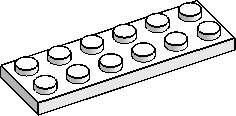 |
3795 | 2×6 Plate | 28 | 4116 |
| 33 (-3) |  |
3068b | 2×2 Tile | 33 | 4088 |
| 34 (-2) |  |
3040 | 2×1 Slope 45° | 33 | 3923 |
| 35 — |  |
87079 | 2×4 Tile | 33 | 3778 |
| 36 (+1) |  |
6636 | 1×6 Tile | 25 | 3609 |
| 37 (+1) |  |
4032 | 2×2 Plate, Round w/ Axle | 21 | 3575 |
| 38 (+6) |  |
15712 | 1×1 Clip, Top | 12 | 3488 |
| 39 — |  |
87087 | 1×1 Brick, Stud 1-side | 27 | 3483 |
| 40 (-6) |  |
33291 | 1×1 Plate, Flower (4 Petals) | 16 | 3464 |
| 41 (-1) |  |
32062 | Technic Axle 2 Notched | 2 | 3225 |
| 42 — |  |
3622 | 1×3 Brick | 26 | 3168 |
| 43 (-2) |  |
4589 | 1×1 Cone | 34 | 3071 |
| 44 (-1) |  |
4070 | 1×1 Brick, Headlight | 16 | 2986 |
| 45 — |  |
3941 | 2×2 Brick, Round w/ Axle | 26 | 2898 |
| 46 (+18) |  |
85861 | 1×1 Plate, Round w/ hole | 17 | 2830 |
| 47 (+3) |  |
99780 | 1×2 Bracket, Inverted | 15 | 2802 |
| 48 — |  |
3460 | 1×8 Plate | 24 | 2780 |
| 49 (-2) |  |
32123 | Technic Bush 1/2 Smooth with Axle Hole Semi-Reduced | 2 | 2769 |
| 50 (-4) | 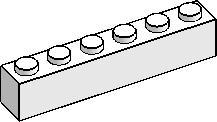 |
3009 | 1×6 Brick | 27 | 2673 |
Analysis
While it’s interesting to simply look through a long list of common LEGO parts, it’s more interesting to look for those parts which stand out. Let’s learn more about the distribution of parts, see which parts come in the most colors, and highlight those parts which are gaining (and decreasing) in popularity.
Part Distribution
While there are well over a thousand unique molds, not all parts are created in equal quantities. The most common part is 1×2 plate (part 3023)—if you bought one of every set from that 5-year period, you would have over 25,000 of that part alone, accounting for 3.8% of your pieces.
By contast, there are many parts which are included in just one set. It’s amazing that they are willing to design and cast a mold to produce a part for just one set! (A lot of unique molds are created for Minifigures and accessories used in the popular Collectible Minifigure Series—It must be profitable!)
When we look at this variability across a large pool of data, we are trying to understand its distribution. In cases like this where a relatively small number pieces of make up the bulk of the collection, we describe the data as having a long-tail distribution.
The good news for people who want a beautifully organized LEGO collection is that you can sort 50% of your collection by part using around 50 compartments, or 90% of your collection by part with fewer than 500 compartments.
The bad news is that the long tail is quite long; In the chart, I only showed the top 500 pieces, but there are thousands more pieces extending off the right side of the chart. There are thousands of unique parts in production, and that’s not including printed parts, minifigures, and retired parts. If you aren’t careful, you will have a lot of tiny drawers with just a single part in it.
Colors
The current LEGO palette includes 41 solid colors, 14 transparent, 8 metallic, 1 glow-in-the-dark white, and 2 transparent with glitter, for a total of 66 colors. This includes the addition of 353Vibrant CoralCoral this year, and last year’s re-introduction of 107Bright Bluish GreenDark Turquoise / Teal.
Some parts are available in a lot of colors and some parts are only in one or a few colors. Typically, parts which are only in one color are functional or connective parts that are not very visible in a finished model. The best example of this are Technic pins and axles which are generally only one color to aid in sorting and finding the right piece well building a model. To help in reading the part list below, you will find that parts which appear in five or fewer colors are shown with a light gray background.
In a different article, we will look at which colors are most common, but I did want to highlight those parts which are available in the most different colors.
Top 25 Parts by Number of Colors
| Rank | Image | Part ID | Part Name | # Colors | Most Common Color |
|---|---|---|---|---|---|
| 5 — |  |
54200 | 1×1 Slope 30° (Cheese) | 50 | 194Medium Stone GreyLight Bluish Gray |
| 1 — |  |
3023 | 1×2 Plate | 49 | 194Medium Stone GreyLight Bluish Gray |
| 3 — |  |
3024 | 1×1 Plate | 46 | 1White |
| 7 — |  |
3069b | 1×2 Tile | 45 | 194Medium Stone GreyLight Bluish Gray |
| 9 — |  |
3005 | 1×1 Brick | 42 | 1White |
| 2 — |  |
4073 | 1×1 Plate, Round | 40 | 315. Silver Metallic (Flat Silver) |
| 16 (+1) |  |
3070b | 1×1 Tile | 40 | 194Medium Stone GreyLight Bluish Gray |
| 6 — |  |
3004 | 1×2 Brick | 39 | 26Black |
| 22 — |  |
11477 | 2×1 Curved | 39 | 26Black |
| 21 (-1) |  |
2431 | 1×4 Tile | 38 | 194Medium Stone GreyLight Bluish Gray |
| 18 (-3) |  |
3003 | 2×2 Brick | 37 | 194Medium Stone GreyLight Bluish Gray |
| 8 — |  |
3710 | 1×4 Plate | 34 | 194Medium Stone GreyLight Bluish Gray |
| 10 — |  |
3020 | 2×4 Plate | 34 | 194Medium Stone GreyLight Bluish Gray |
| 26 — |  |
3062b | Brick Round 1 x 1 Open Stud | 34 | 1White |
| 30 (+6) |  |
15068 | 2×2 Curved | 34 | 26Black |
| 43 (-2) |  |
4589 | 1×1 Cone | 34 | 1White |
| 33 (-3) |  |
3068b | 2×2 Tile | 33 | 194Medium Stone GreyLight Bluish Gray |
| 34 (-2) |  |
3040 | 2×1 Slope 45° | 33 | 194Medium Stone GreyLight Bluish Gray |
| 35 — |  |
87079 | 2×4 Tile | 33 | 194Medium Stone GreyLight Bluish Gray |
| 15 (+1) |  |
98138 | 1×1 Tile, Round | 32 | 194Medium Stone GreyLight Bluish Gray |
| 23 (+2) |  |
85984 | 1×2 Slope 30° (Double Cheese) | 32 | 194Medium Stone GreyLight Bluish Gray |
| 25 (-1) |  |
3010 | 1×4 Brick | 32 | 1White |
| 82 (-3) |  |
50950 | 3×1 Curved | 32 | 1White |
| 20 (+1) |  |
3623 | 1×3 Plate | 31 | 194Medium Stone GreyLight Bluish Gray |
| 60 (+6) |  |
6091 | 1×2×1⅔ Curved | 31 | 1White |
Additional Considerations: It important to note that in a few rare cases, a different part ID is used when nearly the same element is made using solid versus transparent plastic. This can make those parts appear to come in fewer colors than they really do.
An evolving library of parts
In addition to offering a detailed list of the most common parts, I took the extra step of comparing how common the part is based on the last five years versus a window starting one year earlier. When a part has significantly increased or decreased in the rankings, this reflects a shift towards important new parts and away from parts which are not as widely used anymore.
Increase or decrease is measured as a percentage of current ranking, rather than the number of steps it went up or down. This is due to the fact that it’s much harder to go up by one step near the top than lower in the rankings.
31 pieces jumped up in the rankings by 20% or more, and 67 pieces jumped by 10% or more. Most of these are relatively new pieces that filled an obvious gap in the LEGO parts library. Because they are general-purpose parts, they were quickly adopted by LEGO set designers and can be found in many new sets.
Increase of 20% or more
| Rank | Image | Part ID | Part Name | # Colors | # Pieces |
|---|---|---|---|---|---|
| 497 (+84.71%) |  |
36840 | Bracket 1 x 1 – 1 x 1 Inverted | 6 | 169 |
| 319 (+74.29%) |  |
35480 | Plate, Modified 1 x 2 Rounded with 2 Open Studs | 9 | 342 |
| 103 (+48.54%) |  |
25269 | Tile Round 1 x 1 Quarter | 26 | 1309 |
| 283 (+48.06%) |  |
33909 | Tile Special 2 x 2 with Only 2 studs | 10 | 402 |
| 294 (+42.18%) |  |
27925 | Tile 2 x 2 Macaroni | 18 | 389 |
| 46 (+39.13%) |  |
85861 | 1×1 Plate, Round w/ hole | 17 | 2830 |
| 413 (+37.77%) |  |
29119 | Wedge 2×1 with Stud Notch Right | 12 | 226 |
| 200 (+34%) |  |
26047 | Plate 1 x 1 Rounded with Handle | 8 | 591 |
| 412 (+33.74%) |  |
29120 | Wedge 2×1 with Stud Notch Left | 12 | 227 |
| 440 (+33.64%) |  |
25214 | Brick Round 1 x 1 diameter Tube with 90 Degree Elbow(2 x 2 x 1) and Axle Holes(Crossholes) at each end | 8 | 212 |
| 235 (+33.62%) |  |
26601 | Wedge Plate 2 x 2 Cut Corner | 16 | 486 |
| 255 (+32.94%) |  |
26603 | 2×3 Tile | 14 | 441 |
| 104 (+31.73%) |  |
24866 | Plant, Flower 1 x 1 | 14 | 1305 |
| 302 (+31.13%) |  |
32952 | Brick 1 x 1 x 1 2/3 with Studs on 1 Side | 14 | 380 |
| 142 (+30.28%) |  |
24201 | Slope Curved 2 x 1 Inverted | 14 | 901 |
| 424 (+29.48%) |  |
32803 | Slope Curved 2 x 2 Inverted | 6 | 223 |
| 140 (+28.57%) |  |
20482 | Tile Round 1 x 1 with Pin | 13 | 924 |
| 329 (+27.96%) |  |
32607 | Plant, Plate 1 x 1 Round with 3 Leaves | 5 | 325 |
| 484 (+26.45%) |  |
32828 | Plate Round 1 x 1 with Hole and Horizontal Bar | 3 | 182 |
| 278 (+26.26%) |  |
22961 | Technic Pin Connector Hub with 1 Axle | 6 | 405 |
| 280 (+26.07%) |  |
28192 | Slope 45┬░ 2 x 1 with 2/3 Inverted Cutout and no stud | 10 | 404 |
| 461 (+26.03%) |  |
34103 | Plate Special 1 x 3 with 2 Studs with Groove and Inside Stud Holde | 10 | 197 |
| 256 (+23.83%) |  |
26604 | Brick Special 1 x 1 with Studs on 2 Adjacent Sides | 5 | 439 |
| 500 (+23%) |  |
22890 | Plate Special 1 x 2 with End Towball | 1 | 168 |
| 102 (+22.55%) |  |
18654 | Technic Pin Connector Round 1L [Beam] | 10 | 1338 |
| 262 (+22.52%) |  |
24316 | Technic Axle 3 with Stop | 1 | 425 |
| 78 (+21.79%) |  |
22885 | 1×2×1⅔ Brick, 4 Studs 1-side | 7 | 1768 |
| 206 (+21.36%) |  |
99563 | Money / Gold Bar [Ingot] | 9 | 570 |
| 224 (+20.54%) |  |
21459 | Weapon Sword / Katana / Shamshir with Capped Pommel [Square Guard] | 9 | 525 |
| 362 (+20.44%) |  |
24307 | Wedge Plate 2 x 2 Right | 13 | 278 |
| 30 (+20%) |  |
15068 | 2×2 Curved | 34 | 4282 |
While are lots of pieces which have gone down a few positions in the ranking, just 28 pieces have decreased in the rankings by 10% or more. That’s a lot fewer pieces than those which increased by the same percentage.
Decrease of 10% or more
| Rank | Image | Part ID | Part Name | # Colors | # Pieces |
|---|---|---|---|---|---|
| 117 (-30.77%) |  |
15379 | Technic Link Tread with Beveled Edge | 2 | 1170 |
| 292 (-25%) |  |
61184 | Technic Pin 1/2 with 2L Bar Extension | 2 | 390 |
| 491 (-23.63%) |  |
13971 | Wheel 18 x 8 with Fake Bolts and Deep Spokes with Inner Ring | 3 | 178 |
| 18 (-16.67%) |  |
3003 | 2×2 Brick | 37 | 6244 |
| 314 (-15.92%) |  |
4079b | Minifig Seat 2 x 2 with Center Sprue Mark | 10 | 351 |
| 322 (-15.84%) |  |
2458 | Brick Special 1 x 2 with Pin | 7 | 338 |
| 120 (-15.83%) |  |
30374 | Bar 4L (Lightsaber Blade / Wand) | 17 | 1145 |
| 425 (-15.29%) |  |
32001 | Technic Plate 2 x 6 [5 Holes] | 6 | 223 |
| 308 (-15.26%) |  |
58176 | Light Cover with Internal Bar / Bionicle Barraki Eye | 11 | 363 |
| 40 (-15%) |  |
33291 | 1×1 Plate, Flower (4 Petals) | 16 | 3464 |
| 476 (-14.92%) | 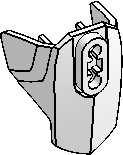 |
90640 | Hero Factory Armor with Ball Joint Socket – Size 4 | 24 | 188 |
| 444 (-14.19%) |  |
30162 | Equipment Binoculars | 4 | 211 |
| 289 (-14.19%) |  |
2817 | Plate Special 2 x 2 with 2 Pin Holes | 4 | 392 |
| 61 (-13.11%) |  |
3700 | 1×2 Technic Brick, 1 Hole | 16 | 2297 |
| 168 (-12.5%) |  |
6231 | Panel 1 x 1 x 1 Corner | 13 | 778 |
| 371 (-12.4%) |  |
32530 | Technic Pin Connector Plate 1 x 2 x 1 2/3 [Two Holes On Top] | 5 | 269 |
| 226 (-12.39%) |  |
6587 | Technic Axle 3 with Stud | 2 | 512 |
| 471 (-12.1%) |  |
3742 | Plant, Flower – Small | 5 | 190 |
| 358 (-12.01%) |  |
50745 | Mudguard 4 x 2 1/2 x 2 with Arch Round | 16 | 282 |
| 386 (-11.92%) |  |
3679 | Turntable 2 x 2 Plate – Top | 1 | 259 |
| 178 (-11.8%) |  |
32525 | Technic Beam 1 x 11 Thick | 14 | 735 |
| 439 (-11.16%) |  |
64782 | Technic Panel 1 x 5 x 11 | 10 | 213 |
| 350 (-11.14%) |  |
2476 | Plate Special 2 x 2 with Pin on Bottom | 3 | 289 |
| 163 (-11.04%) |  |
10247 | Plate Special 2 x 2 with 1 Pin Hole [Complete Underside Rib] | 6 | 790 |
| 297 (-10.44%) |  |
3045 | Slope 45┬░ 2 x 2 Double Convex | 17 | 387 |
| 422 (-10.43%) |  |
42446 | Neckwear Bracket [One Stud] | 6 | 223 |
| 166 (-10.24%) | 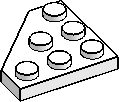 |
2450 | Wedge Plate 3 x 3 Cut Corner | 19 | 782 |
| 473 (-10.15%) |  |
32271 | Technic Beam 1 x 9 Bent (7 – 3) Thick | 11 | 190 |
| 379 (-10.03%) |  |
56145 | Wheel 30.4 x 20 without Pinholes, with Reinforced Rim | 9 | 264 |
It makes sense that new elements gain popularity quickly as they are included in a lot of new sets, but fade out of popularity much more slowly as building styles evolve over time.
The LEGO community gets really excited about the introduction of new parts, but barely notices when older parts are retired. I guess you can say that the “cult of the new” is real for LEGO fans.
See Also
If you enjoyed this article, you might also enjoy…
Learn 7 styles of architecture using LEGO. The book includes a brief history of each style, photos of amazing buildings to use for inspiration, and instructions to get started. Written by Brick Architect founder Tom Alphin.
4.7 Stars at Amazon, and available in 10 languages.
Get Organized! My LEGO Storage Guide offers in-depth suggestions to organize, sort, and store a LEGO collection of any size. Be sure to take a look, as there are some great storage rpducts for the LEGO Lover on your shopping list.
See how a well organized LEGO collection can unlock creativity!
Plastic drawer cabinets by Akro-Mils are the top pick for most LEGO enthusiasts in the USA. The drawers are easily removed and stack-able, deep enough for 16-stud bricks, flexible which makes them durable, and competitively priced.
Add printable LEGO Brick Labels for the ultimate in organization!
Conclusions
I was surprised to learn that the #1 piece accounts for 3.7% of parts produced, and the top 50 parts account for 50% of the parts which are produced. While I already knew that LEGO parts followed a long-tail distribution, I continue to be amazed by their willingness to create new parts which aren’t used very often. The only way it makes sense to design and create specialty molds which are used for only a few sets is if they have learned how to make high-quality molds much more cheaply that I was led to believe, or if they are making a ton of money from sets with specialy parts. (Both are likely true.)
I was also surprised to see how quickly new parts enter the mainstream… Every year, the LEGO Group introduces a few parts which are so useful that they get used in a ton of sets. While the changes in a single year caused by new System and Technic parts is fairly small, the change over a period of 5-10 years is remarkable. It’s hard to imagine building LEGO models without classic bricks and plates, as well as new classics like the 2×2 Jumper or 1×2 brackets. In the near future, people will look at parts like 1 x 2 Rounded with 2 Open Studs in the same way—how did LEGO builders live without it?
Subscribe
Here at Brick Architect, were always looking for the next great content. This includes detailed reviews of new sets, LEGO Storage ideas, and in-depth articles like this one.

Subscribe to the Brick Architect newsletter for early access to exclusive content, the latest articles, and updates to the Printable LEGO Brick Labels, LEGO Storage Guide, and my book The LEGO Architect.

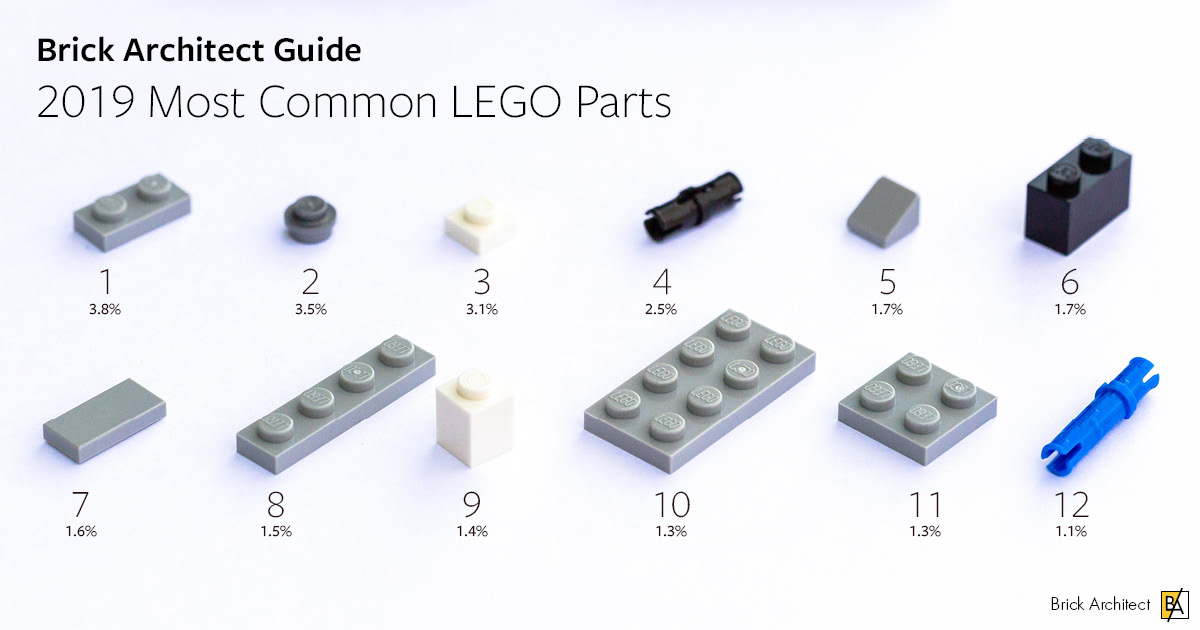
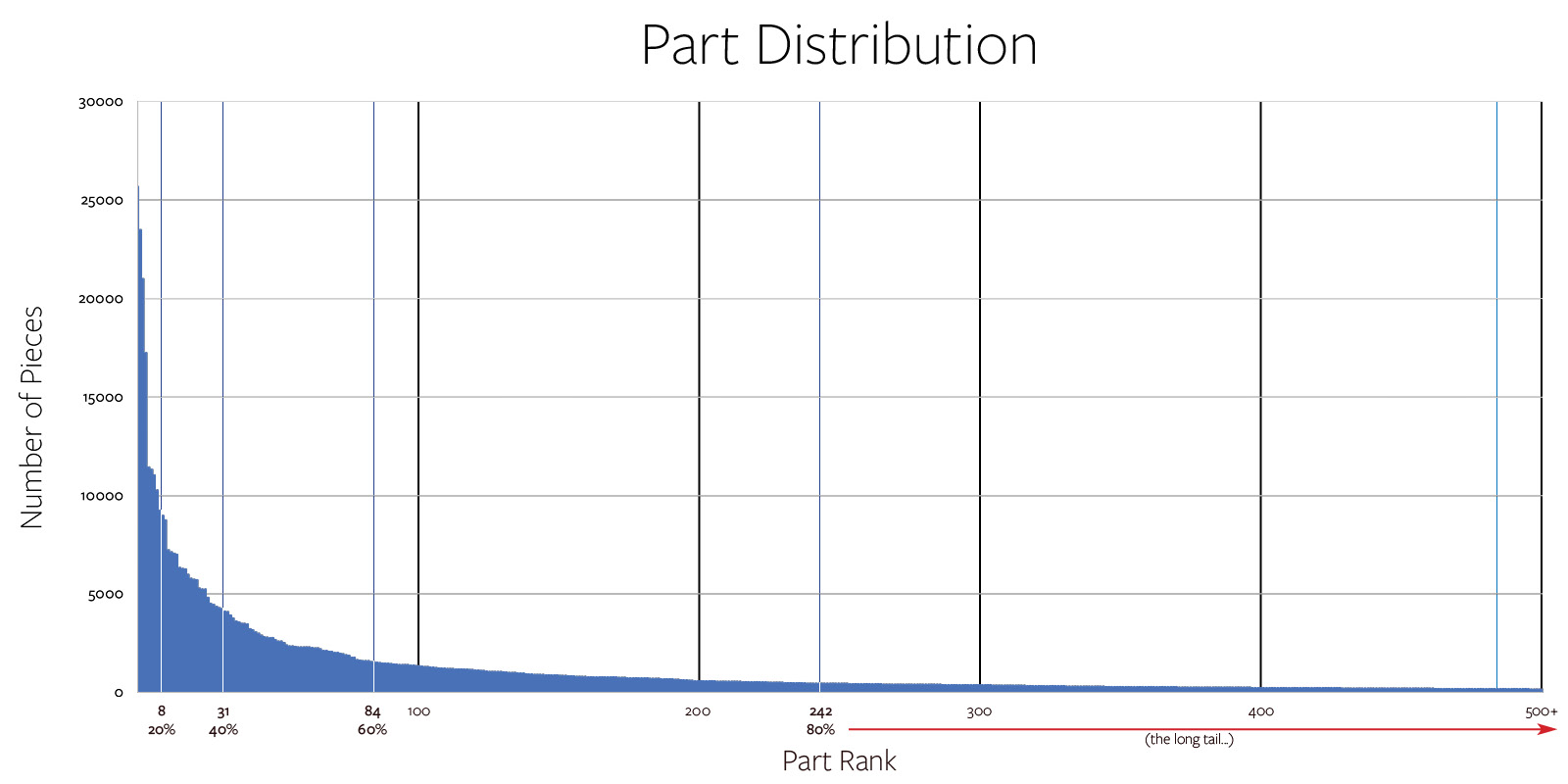

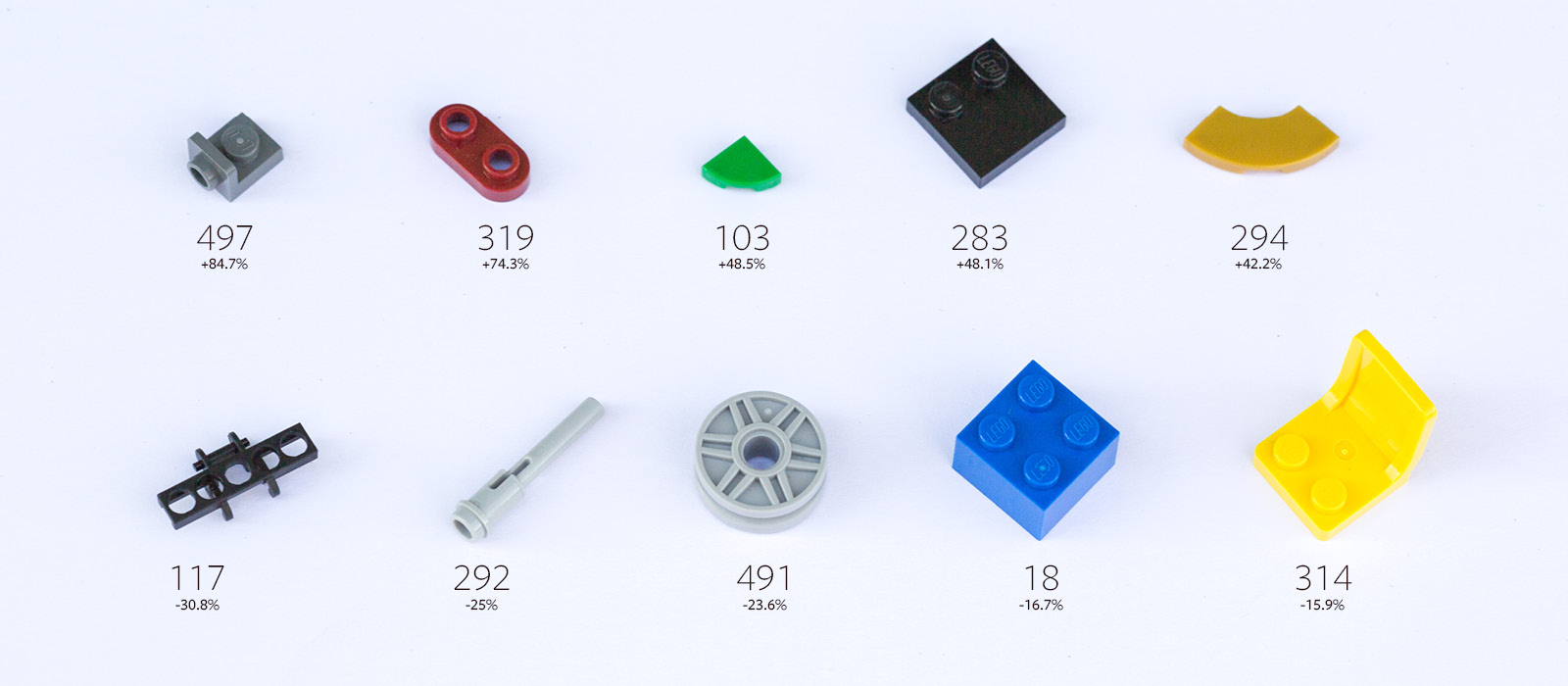
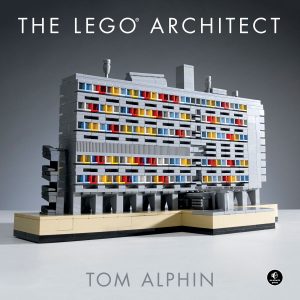
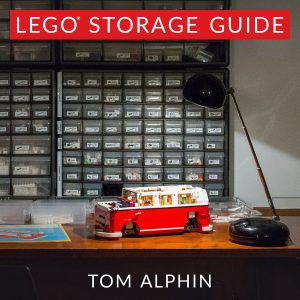

I love your book. I was given the Lego Architecture set for Christmas. Your models in the book have been small and I sometimes don’t have enough parts to complete them. I have 5 models from the book: Wingspread and Robie House page 30,Talisen West page 33,Ocean Restaraunt-page 51 and National Congress of Brazil-page 78 that I would like to build, among others that I have seen on Pintrest. Do you have plans and the parts list for any other projects such as these or know where to obtain them? I just ordered one building from Brick Depot, however I am looking for more contempoary designs. I have been building Lego Sets for the last 35 years. I am retired and have the time and funds. But I have no idea how to create one. I would love to build a model of our new home built on hill about 4 years ago. Any advice or point me in the right direction would be appreciated. Thank You
Jeff,
Very few of the models in the book were built digitally, which is pretty much a requirement in order to create building instructions. Realistically, the very large models in the book are not meant for you to re-create at home, so much as to provide inspiration for the types of things you could build as you become a more experienced LEGO Artist.
I will say that Paul Wellington, who designed the National Congress of Brazil model did make his model digitally, and might be able to share instructions. I interviewed him here: https://brickarchitect.com/2015/paul-wellington/ and he has a contact form on his website here: https://pawellington.com/
Sincerely,
—tom
Really interesting analysis. It would be interesting to see how the ‘tail’ of the distribution evolved over the years. If i had to guess, i would say it is elongating much more quickly now than before (but at which rate is the question)
Tom. Great article as always. Some of my quick observations without getting into the data too much are:
•The number one spot has more than double the number five spot in terms of overall parts quantity. That seems fascinating to me because it is *so far ahead* of number five in terms of quantity. What a huge jump that is!
•The top five parts total quantity is about 100,000 pieces. It takes twelve more parts to match that quantity. To me that tells me that the first five parts are extraordinarily common and reaffirmed how common they really are.
Nice data mining! I’d be interested to know what the standard deviation is between the parts in the top 50 are.
Adding standard deviation is a good idea and I might try this next time.
Thanks for the suggestion!